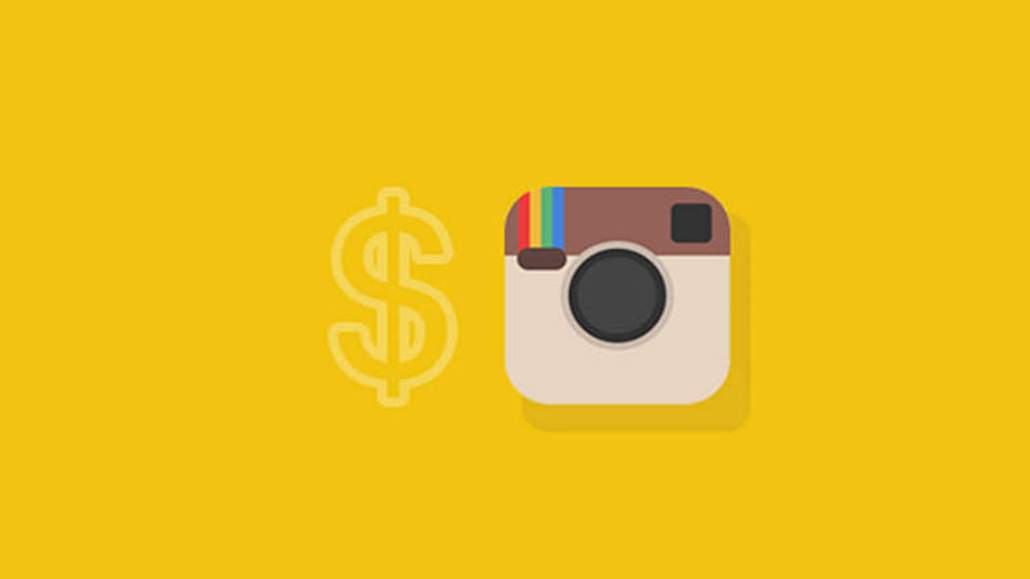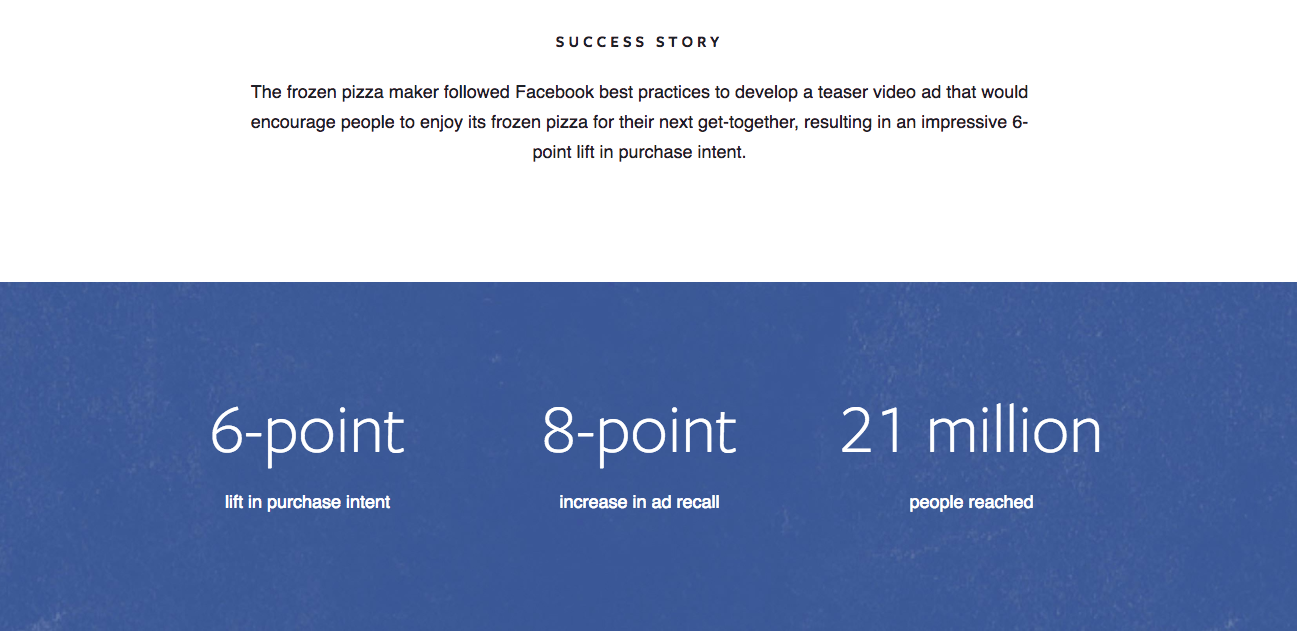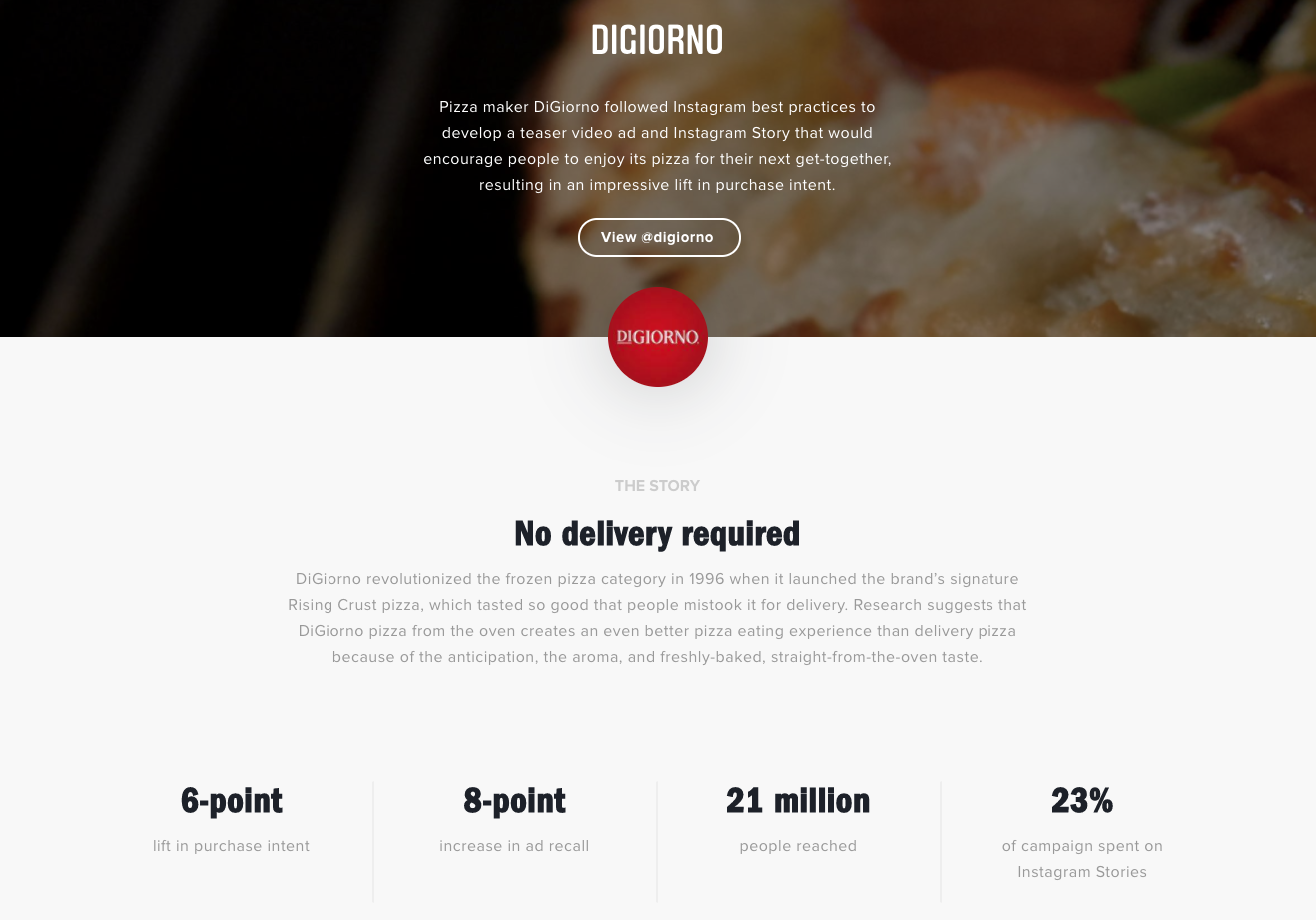
Facebook and Instagram are pitching themselves to buyers as a cross-platform play, if their recent case studies are anything to go by. An increasing number of case studies on Instagram include numbers gleaned from Facebook campaigns.
For instance, a Woodford Reserve case study on Instagram showed the brand switching to mobile-optimized video ads during the Kentucky Derby and achieving a 12 percent increase in brand awareness. It’s the same as a case study for the product on Facebook — except the Instagram case study said it used both Facebook’s and Instagram’s best practices, while the Facebook one said it used Facebook’s best practices.
“The Woodford Reserve team partnered with Facebook’s Creative Shop and creative agency Kertis Creative to repurpose its TV commercial into two mobile-optimized video ads for both Facebook and Instagram,” reads the text under the result.
Another example is a case study for DiGiorno pizza on both Facebook’s and Instagram’s business pages that shows 21 million people reached and a six-point increase in purchase intent. The Instagram case study also includes how many people were reached on that platform’s Stories product.


Ad position: web_incontent_pos1
Each case study mentions that both platforms were used, although where they disclose this differs.
Nate Elliott, principal at Nineteen Insights and a former Forrester analyst, said he studied 50 case studies from 2016 on social networks. In 2016, only one Instagram case study mirrored a Facebook case study. But this year, he said he found that a third of case studies supplied on Instagram had the same results as the same campaign on Facebook, noting examples from brands including Sonos, Pura Vida and Sour Patch Kids.
One buyer said it’s not about hiding where the results come from, but that Facebook and Instagram are “subtly selling how effective cross-platform campaigns can be through whichever entry points brands or agencies are comfortable with.” The buyer said the interesting thing is how Facebook is pitching both products. Facebook used to recommend running different creative campaigns on Instagram and Facebook, but it now says it’s best practice to use both platforms for the same.
Another buyer said for larger campaigns, Facebook has begun packaging the offerings together, with advertisers often messaging across the Facebook platform — in-stream, Instagram, Facebook and Facebook Audience Network. Then, that’s coupled with one-off tactics to do specific things on, say, Stories or Messenger. “Outside of the scale benefit, doing this allows advertisers to control frequency and automatically optimize cross-platform,” said this buyer.
Most buyers agree there’s no deception, but Facebook and Instagram need to break down platform-specific results. “If I paid for Instagram ads and received a bunch of impressions from Facebook, I might be upset because it impacts my Facebook strategy. They aren’t the same necessarily,” said Justin Johnson, a freelance creative strategist.
Ad position: web_incontent_pos2
“The results for each case come across as a little deceiving. For example, one might think they accumulated 21 million impressions on just Instagram after quickly scanning the case study,” said a buyer. “If you actually read the case study, they are transparent and note that it was run across both platforms. However, they don’t disclose the breakdown across both platforms.”
That’s by design, as Facebook is positioning itself more as a “network” with Instagram than it has previously, said another buyer. “Grouping Facebook and Instagram together is a recent trend because they’re now able to deliver the best results if you’re using both,” said Brendan Gahan, evp at Epic Signal. Facebook, however, is likelier to deliver the majority of results compared to Instagram because it’s simply bigger, he added.
Platform-supplied case studies are a curious beast in general. They’re marketing material — essentially ads for the platform themselves. Most agencies develop their own case studies.
“We look at case studies like this often, but in aggregate. In addition, we would never consider a case study enough ‘evidence’ to run on a particular platform or with a specific tactic,” said one head of paid media at an agency. “They are merely directional guides that showcase common scenarios with specific verticals, client types.”
Ross Benes contributed reporting
More in Marketing

In the marketing world, anime is following in the footsteps of gaming
As marketers look to take advantage of anime’s entry into the zeitgeist, they might be wise to observe the parallels between the evolution of anime as a marketing channel and the ways brands have learned to better leverage gaming in recent years.

With the introduction of video ads and e-commerce, Roblox looks to attain platform status
Roblox is expanding into more areas than just ads in 2024. Much like platforms such as Amazon and Facebook have transcended their origins to evolve from their origins as online marketplaces and social media channels, Roblox is in the midst of a transformation into a platform for all elements of users’ virtual lives.

PepsiCo wants to remain a ‘driver of culture’ as it turns to influencers and activations amid rebrand
The soda-maker says it can translate cultural relevance into sales volume.
Ad position: web_bfu


